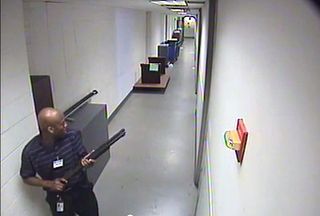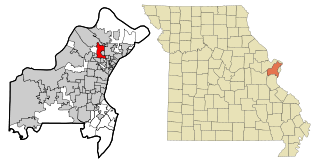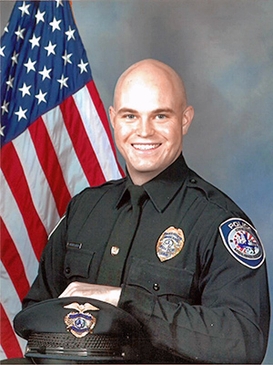
The Saint Valentine's Day Massacre was the murder of seven members and associates of Chicago's North Side Gang on Saint Valentine's Day 1929. The men were gathered at a Lincoln Park, Chicago garage on the morning of February 14, 1929. They were lined up against a wall and shot by four unknown assailants, two of whom were disguised as police officers.

The Fort Worth Police Department (FWPD) is the police department of Fort Worth, Texas, United States. Neil Noakes is the Chief of Police.
In the United States, a no-knock warrant is a warrant issued by a judge that allows law enforcement to enter a property without immediate prior notification of the residents, such as by knocking or ringing a doorbell. In most cases, law enforcement will identify themselves just before they forcefully enter the property. It is issued under the belief that any evidence they hope to find may be destroyed between the time that police identify themselves and the time they secure the area, or in the event where there is a large perceived threat to officer safety during the execution of the warrant.

The Trolley Square shooting was a mass shooting that occurred on the evening of February 12, 2007, at Trolley Square Mall in Salt Lake City, Utah, United States. A gunman identified as Sulejman Talović killed five bystanders and wounded four others before being shot dead by several members of the Salt Lake City Police Department. Authorities were not able to determine a motive.
The Joe Horn shooting controversy occurred on November 14, 2007, in Pasadena, Texas, United States, when local resident Joe Horn shot and killed two burglars outside his neighbor's home. Recordings of Horn's exchange with emergency dispatch indicated that he was asked 14 times not to interfere with the burglary, because police would soon be on scene. The shootings resulted in debates regarding self-defense, castle doctrine laws, and Texas laws relating to use of deadly force to prevent or stop property crimes. The undocumented status of both burglars was highlighted because of the U.S. border controversy. On June 30, 2008, Horn was cleared by a grand jury in the Pasadena shootings.
William Erwin Walker, also known as Erwin M. Walker and Machine Gun Walker, was an American police employee and United States Army World War II veteran, known for having committed several thefts, burglaries, and shootouts with police in Los Angeles County, California, in 1945 and 1946, one of which resulted in a fatality. The film He Walked by Night (1948) was loosely based on Walker's 1946 crime spree.

The Washington Navy Yard shooting occurred on September 16, 2013, when 34-year-old Aaron Alexis fatally shot 12 people and injured three others in a mass shooting at the headquarters of the Naval Sea Systems Command (NAVSEA) inside the Washington Navy Yard in southeast Washington, D.C. The attack took place in the Navy Yard's Building 197; it began around 8:16 a.m. EDT and ended when police killed Alexis around 9:25 a.m. It is the deadliest mass shooting in Washington, D.C. history, as well as the second deadliest mass murder on a U.S. military base, behind the 2009 Fort Hood shooting.

On August 9, 2014, 18-year-old Michael Brown was shot and killed by police officer Darren Wilson in Ferguson, Missouri, a suburb of St. Louis.

The Ferguson unrest was a series of protests and riots which began in Ferguson, Missouri on August 10, 2014, the day after the fatal shooting of Michael Brown by FPD officer Darren Wilson. The unrest sparked a vigorous debate in the United States about the relationship between law enforcement officers and Black Americans, the militarization of police, and the use-of-force law in Missouri and nationwide. Continuing activism expanded the issues by including modern-day debtors prisons, for-profit policing, and school segregation.

On November 22, 2014, Tamir E. Rice, a 12-year-old African American boy, was killed in Cleveland, Ohio, by Timothy Loehmann, a 26-year-old white police officer. Rice was carrying a replica toy gun; Loehmann shot him almost immediately upon arriving on the scene. Two officers, Loehmann and 46-year-old Frank Garmback, were responding to a police dispatch call regarding a male who had a gun. A caller reported that a male was pointing "a pistol" at random people at the Cudell Recreation Center, a park in the City of Cleveland's Public Works Department. At the beginning of the call and again in the middle, he says of the pistol "it's probably fake." Toward the end of the two-minute call the caller states that "he is probably a juvenile", but the dispatcher did not relay either of these statements to Loehmann and Garmback.
Akai Gurley, a 28-year-old black man, was fatally shot on November 20, 2014, in Brooklyn, New York City, United States, by a New York City Police Department officer. Two police officers, patrolling stairwells in the New York City Housing Authority (NYCHA)'s Louis H. Pink Houses in East New York, Brooklyn, entered a pitch-dark, unlit stairwell. Officer Peter Liang, 27, had his firearm drawn. Gurley and his girlfriend entered the seventh-floor stairwell, fourteen steps below them. Liang fired his weapon; the shot ricocheted off a wall and fatally struck Gurley in the chest. A jury convicted Liang of manslaughter, which a court later reduced to criminally negligent homicide.

The shooting of Antonio Martin occurred on December 23, 2014, in Berkeley, Missouri, a suburb of St. Louis. Martin, an 18-year-old black male, was fatally shot by a white Berkeley police officer when Martin pulled a gun on him. The shooting sparked protests in the St. Louis area and other cities in the U.S. The shooting elicited comparison to the earlier shooting death of Michael Brown two miles away in Ferguson, Missouri.

The killing of Tony Terrell Robinson Jr. occurred on March 6, 2015, in Madison, Wisconsin. Robinson, an unarmed 19-year-old man, was fatally shot by Madison police officer Matthew Kenny during a "check-person" call. Kenny was responding to dispatch reports that Robinson was jumping in front of cars and acting erratically, and that he had harmed someone in an apartment. On May 12, 2015, the shooting was determined to be justified self-defense by the Dane County District Attorney Ismael Ozanne. The death was protested by the Black Lives Matter movement; Robinson was biracial, with a black father and a white mother.

On July 18, 2016, Charles Kinsey, a behavior therapist, was shot in the leg by a police officer in North Miami, Florida. Kinsey had been retrieving his 27-year-old autistic patient, Arnaldo Rios Soto, who had run away from his group home. Police encountered the pair while they were searching for an armed suicidal man. Kinsey was lying on the ground with his hands in the air, and trying to negotiate between officers and his patient, when he was shot. The officer who shot Kinsey said he had been aiming at the patient, who the officer believed was threatening Kinsey with a gun. Both Kinsey and his patient were unarmed.
On January 6, 2017, a mass shooting occurred at Fort Lauderdale–Hollywood International Airport in Broward County, Florida, United States, near the baggage claim in Terminal 2. Five people were killed while six others were injured in the shooting. About 36 people sustained injuries in the ensuing panic. Esteban Santiago-Ruiz, who flew in to the airport from Alaska and committed the shooting with a Walther PPS 9mm semi-automatic pistol, was taken into custody by a Broward County Sheriff's Office (BSO) deputy within 85 seconds after he started shooting. The shooting from start to finish lasted 70–80 seconds. Santiago was later diagnosed with schizophrenia and pleaded guilty to avoid possible execution. On August 17, 2018, Santiago was sentenced to five consecutive life sentences plus 120 years in prison.

On the night of September 6, 2018, 26-year-old accountant Botham Jean was murdered in Dallas, Texas by off-duty Dallas Police Department patrol officer Amber Guyger, who entered Jean's apartment and fatally shot him. Guyger, who said that she had entered Jean's apartment believing it was her own and believed Jean to be a burglar, was initially charged with manslaughter. The absence of a murder charge led to protests and accusations of racial bias because Jean—an unarmed black man—was killed in his own home by a white off-duty officer who had apparently disregarded police protocols. On November 30, 2018, Guyger was indicted on a charge of murder. On October 1, 2019, she was found guilty of murder, and was sentenced to ten years' imprisonment the following day. The ruling was upheld on appeal in 2021.

Atatiana Koquice Jefferson, a 28-year-old woman, was fatally shot inside her home by a police officer in Fort Worth, Texas, United States, in the early morning of October 12, 2019. Police arrived at her home after a neighbor called a non-emergency number, stating that Jefferson's front door was open. Police body camera footage showed officers walking outside the home with flashlights for a few minutes then one officer yells, "Put your hands up! Show me your hands!", while discharging his weapon through a window. Police found a handgun near Jefferson's body, which according to her eight-year-old nephew, she was pointing toward the window before being shot. On October 14, 2019, Officer Aaron Dean, the shooter, resigned from the Fort Worth Police Department and was arrested on a murder charge. On December 20, 2019, Dean was indicted for murder. Jefferson was black and the officer who shot her is white, prompting news outlets to compare Jefferson's shooting to the September 2018 murder of Botham Jean in nearby Dallas.
On August 29, 2020, Aaron Danielson, an American supporter of the far-right group Patriot Prayer, was shot and killed after participating in a caravan which drove through Portland, Oregon, displaying banners and signs supporting President Donald Trump, and clashing with participants in the local George Floyd protests.

Sara-Nicole Morales was shot and killed in the front yard of her mother's house in Orange City, Florida, United States. While returning home from her job at a Volusia County library, she had become embroiled in a road rage incident with a local motorcyclist, during which she had intentionally struck his vehicle with hers, an act witnessed by two nearby motorists. The three notified police and followed her to the house, where she confronted them with her fiancé's pistol. The motorcyclist drew his own gun and shot her five times.

Very early on March 5, 2019, Midland, Texas, United States, police officer Nathan Heidelberg was shot and killed while responding with fellow officers to a residence where a burglar alarm had gone off, the first Midland police officer killed on the job in over 50 years. The homeowner, David Wilson, an oil company executive who had fired the fatal shot in the belief that Heidelberg was an intruder attempting to force his way into his family home, was arrested and charged with manslaughter, later increased to murder by a grand jury. In late 2021, he was acquitted.














